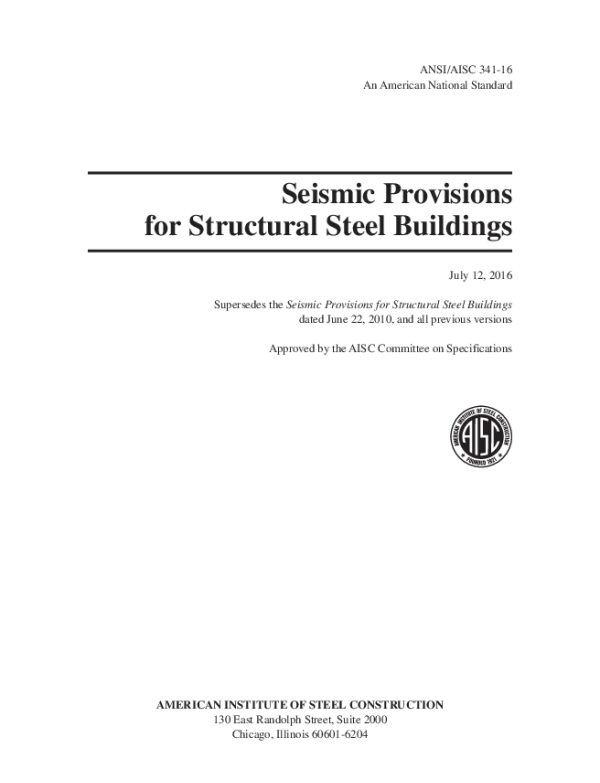-
资源简介
The AISC 341-16 Seismic Provisions for Structural Steel Buildings is a critical document published by the American Institute of Steel Construction (AISC) that provides detailed guidelines for the seismic design of steel structures. This publication is essential for engineers, architects, and construction professionals involved in designing buildings in seismically active regions. The document outlines specific requirements to ensure that steel buildings can withstand earthquake forces and maintain their structural integrity during seismic events.
Seismic provisions are crucial because earthquakes can cause significant damage to buildings if not properly accounted for in the design process. AISC 341-16 addresses this need by offering comprehensive criteria for the design, detailing, and construction of steel structures in areas prone to seismic activity. The provisions are based on the latest research and best practices in seismic engineering, ensuring that the standards remain up-to-date with current scientific understanding and technological advancements.
The document is organized into several sections that cover different aspects of seismic design. These include general requirements, material properties, connection design, member design, and special seismic provisions. Each section provides detailed information on how to apply the seismic provisions effectively. For example, the material properties section discusses the importance of using high-quality steel that meets specific strength and ductility requirements to enhance the building's ability to absorb and dissipate energy during an earthquake.
Connection design is another critical area addressed in AISC 341-16. The document emphasizes the importance of strong and ductile connections that can accommodate the deformations caused by seismic forces. It provides detailed guidance on the types of connections that should be used, as well as the methods for analyzing and designing them to ensure they perform adequately under seismic loading conditions.
Member design is also a key component of the seismic provisions. The document outlines specific requirements for the design of beams, columns, and other structural members to ensure they can resist the forces generated during an earthquake. These requirements include considerations for lateral load resistance, stability, and the overall performance of the structure under dynamic loading conditions.
In addition to these technical details, AISC 341-16 includes special seismic provisions that address unique challenges associated with seismic design. These provisions may include requirements for the use of specific types of steel, such as those with enhanced toughness or improved weldability, which are necessary to ensure the reliability of the structure during an earthquake. The document also provides guidance on the use of advanced analytical techniques, such as nonlinear static analysis, to evaluate the performance of steel structures under seismic loads.
The AISC 341-16 Seismic Provisions for Structural Steel Buildings is widely recognized as a authoritative resource in the field of seismic engineering. It is often referenced in building codes and regulations, particularly in regions where seismic activity is a concern. Engineers and designers rely on this document to ensure that their projects meet the highest standards of safety and resilience against earthquakes.
Furthermore, the document encourages collaboration between different stakeholders in the construction industry, including architects, engineers, and contractors, to ensure that seismic provisions are implemented effectively throughout the design and construction process. By promoting a coordinated approach, AISC 341-16 helps to minimize risks and enhance the overall quality of steel structures in seismically active areas.
Overall, the AISC 341-16 Seismic Provisions for Structural Steel Buildings plays a vital role in advancing the practice of seismic design in the steel construction industry. Its comprehensive guidelines and practical recommendations provide a solid foundation for creating safe, durable, and resilient buildings that can withstand the challenges posed by earthquakes. As new research and technologies continue to emerge, it is expected that future editions of this document will further refine and improve the seismic design standards for steel structures.
-
封面预览

-
下载说明
预览图若存在模糊、缺失、乱码、空白等现象,仅为图片呈现问题,不影响文档的下载及阅读体验。
当文档总页数显著少于常规篇幅时,建议审慎下载。
资源简介仅为单方陈述,其信息维度可能存在局限,供参考时需结合实际情况综合研判。
如遇下载中断、文件损坏或链接失效,可提交错误报告,客服将予以及时处理。